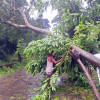Thunderstorms, lightning, and heavy rainfall can be unpredictable. You never know when thunder will strike close to you and leave you with damages, especially to your electronic devices. They often require safety measures and precautions become more imperative during inclement weather.
Here are 3 things you can do to ensure protection for your electronics.
Unplug
This may be a precaution we all hear about but at times, fail to do. Keep in mind that unplugging your devices is the best defence against electrical equipment damage during thunderstorms.
This is the most reliable and safest way to make sure your electrical equipment is protected when thunder strikes.
Unplugged electronics during a thunderstorm puts them at risk of damage from lightning-induced power surges. Power lines can be struck by lightning, which can destroy any electronics attached to them.
Even if you have a whole-home surge protector, it doesn't eliminate all risks. Furthermore, power surges caused by lightning can overload circuits and start fires.
Devices that are unplugged are cut off from the circuit, thus in the event that lightning strikes close by and damages your home's wiring, there is no longer a connection to the electrical system.
Plug-in and surge protectors
Surge protectors, which resemble power strips, make it simple and straightforward to shield electronics from lightning. Similarly, when the electrical panel in your house is connected to a whole-home surge protection device (SPD), it functions much like a filter allowing safe electrical current to go through while preventing the electrical system in your house from receiving dangerously excessive current or voltage.
Before you buy your surge protector, it's best to consult your electrician and do your research online to assess which will be best suited for you.
Most times lightning tends to strike on a shared circuit and can frequently cause damage to several devices at a time. A surge protection system operates by blocking any nearby lightning strikes before they have a chance to enter your home.
To shield electronics from power surges, these devices are a wise investment and may be mounted straight into your circuit breakers.
Building safety and insurance
Despite your best efforts, accidents can still happen. It might be worth talking to your landlord or getting information about your building or apartments' in-built electric security.
While a lightning rod or lightning conductor is used in the building structure to absorb lightning, it does not hurt to be aware of these safety measures. It will also serve you well to have the warranty and insurance papers of your devices in case damage does occur.
It's critical to protect electronics during thunderstorms not just for the safety of your devices but also for you and your home. Unplugging equipment reduces the possibility of lightning-induced power surge damage and maximises the chances of averting possible fires and extending the life of your electronics.
Making these easy safety measures a priority might prevent needless damage and major losses.









Comments